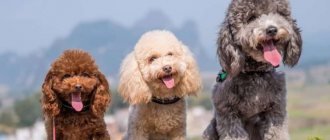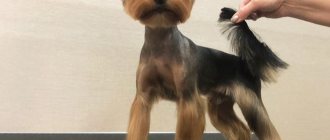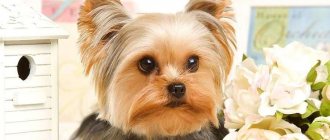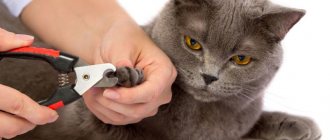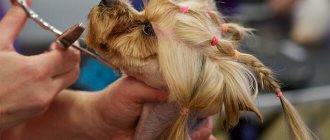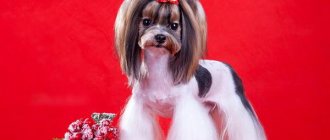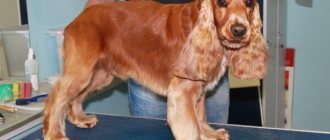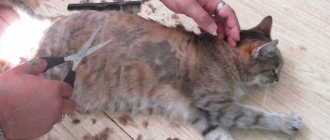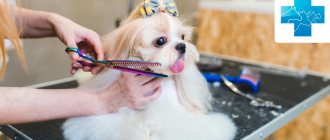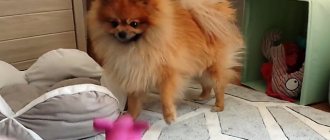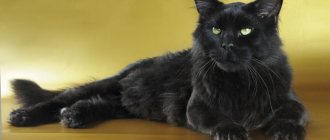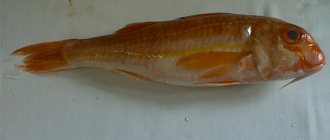How to trim/shave your Black Russian Terrier yourself.
Spring-summer, heat, your blackie has grown over the winter and you understand that it’s time to trim your pet’s hair. On this page I will show and briefly tell you how to shave a Black Russian Terrier so that the dog looks beautiful and is pleasing to the eye. Necessary tools.
- Comb .
- The scissors are long, well sharpened. You can order and buy on AliExpress, preferably no shorter than 8 inches, their cost is about 2 thousand rubles. The steel of these scissors is soft, the scissors become dull rather quickly, but they are quite suitable for home haircuts.
- Shaving machine. You can read about choosing a machine - Caring for a black terrier
- Machine knives. It is best if you have 3 knives and a knife from 5 mm in your set
Where to begin .
Rinse the blackberry. This procedure is simply necessary if you want to save machine knives and scissors. Shaving and cutting dirty wool “kills” your tools and the desire to save time and effort will cost you at least the price of clipper knives. And they are now very expensive.
Briefly about washing and drying. It is necessary to wash the black terrier's fur with shampoo until the soapy water that is washed off is white or clear. Those. lathered, “massaged” the fur, rinsed it off and looked at how clean the wash was. If the shampoo being washed off is gray or even black, lather it again. It is advisable to carry out the first wash with shampoo, which has super-cleaning properties (see the name - this is “deep cleansing”, peeling shampoo, for oily hair, etc.). And, in my opinion, it doesn’t matter whether this shampoo is for dogs or for people. The statement about different PH is a myth, a fairy tale, pure marketing. I once measured the pH of shampoos and conditioners for dogs and people with test strips - there was practically no difference. AND ! You will dilute the shampoo with water, at least in proportions of 1/3. Is it logical that the advertised PH is leveled by water? Logical.
A little secret. To wet a dog, 3 liters of water is enough. Don't believe me? check . Take old used shampoo bottles (I use liter plastic bottles from Domestos, their spout is at an angle - it’s more convenient), pour warm water, add 1-2-3 tablespoons of super-cleansing shampoo, mix, carefully turning the bottle over. You can dilute the shampoo in a bucket or basin and apply this solution with a sponge. The shampoo opens the hair scales, so the hair stops repelling water. For me, 2 liters of solution is usually enough.
Washed? Did you rinse well? Be sure to rinse off the shampoo very well. Otherwise, the coat will be dull, irritation and dandruff may appear. Rinse it off, don't be lazy.
Dry the fur with towels and comb the dog. Yes, wet and comb - it’s easier to untangle the tangles. We combed it, now we dry it. Dry those areas that you won’t shave with a hairdryer while combing, this way the dog will dry faster and, having lost some time and effort in this procedure, you will save in the future, this way the dog’s coat will tangle less and will look beautiful for a longer time, yes and cut it better.
Shaving scheme :
Approximate diagram
We take a machine with a knife of 5 or higher. And we shave according to the pattern.
Points on the diagram:
- 1 in the picture - the place where the paw bends.
- 2 elbow or slightly higher.
- 3 the point above the groin is the top of the curved line belly - thigh. In the photo this point is shifted towards the tail and raised very high. It can be lowered and moved towards the head. If in doubt, take the groin fold and measure up about 5 cm.
- 4 bending point of the hind leg. You can also vary - shave above or below this point.
Shave your back while pulling back the skin. If you want the coat to be a little longer, shave according to the growth of the coat, it may not turn out very carefully, since the hair will not be cut evenly, but after a couple of weeks you will not notice this. If you shave against the grain, the cut will be more even. Shaved your back? Now we use a machine to mark the transition lines from shaved to long wool (drawn in the photo). Walk along these visually outlined lines with a machine, even if it is somewhat uneven, you can trim it later. According to the diagram, there are two lines on the front paw - choose any one you like best. If along a bright line, it will be somewhat more difficult to align later, but the dog, in my opinion, will look more stylish. If the dog is very overgrown and it is not very convenient to mark a line with a clipper, in this case take scissors and cut the hair from the elbow, repeating the bottom line.
Next, shave the sides, front, and back to the designated lines/points. In the front, you can leave the long hair in a triangle or just a straight strip from the chest bone down. Or you can shave it completely, then it’s worth shaving the skirt too, i.e. You don’t have to mark line 2-3, but shave the entire body.
Shave your ears from the outside and inside. Draw a line down from the base of your ear and shave your neck along it. I shave deeper, closer to the eyes, i.e. I retreat 1-2 cm from the base of the ear - this way the ear “breathes” better.
We shave the dog's rear (backside). It's simple - shave everything down to point 4. Shave the back legs and the inside along line 3-4.
Next, at first glance, the most difficult thing is the decoration and transition from shaved to long wool. Frame. Use a machine to straighten the intended transition lines. Next, comb the long hair on the body, style it, combing from top to bottom and, repeating the line of the shaved body, cut it. There is no need to take a piece of wool and trim it, the wool will still look like that - in shreds. I'll post a photo or video later.
Legs . Trim your nails. Shave or trim the fur between the paw pads. Comb the bottom of the paw, laying everything down. Next, grab the paw near the very pads, grabbing the fur, lift the paw and cut off everything that extends beyond the contour of the paw. (there will also be a photo explanation). Place the dog, front paws d.b. parallel to each other, trim the bottom of the paws, aligning them in a circle.
The upper part of the front paws (decoration). Comb the decorating hair, then use a slicker brush to lift the hair up. Cut to the length you like best, but try to make even columns. If you combed it poorly during drying, it’s unlikely to work out exactly, and if there are tangles left, then it will be a complete mess.
Hind legs . Comb the decorating hair from top to bottom and cut it with scissors, following the contour of the thigh and lower leg to the metatarsus. The metatarsus can be shaped in the same way as the front legs - in a column, of course, taking into account the hair on the lower leg. Photos (probably video) will be posted a little later.
If your blackie is shaving for the first time, then to avoid scratching until it becomes scabby, wash the dog, dry it and lubricate the shaved area with aftershave cream (I use “Rescuer” balm for these purposes).
the dog is shaved
Good luck!
see also
Grooming of the Black Russian Terrier. Diagrams and explanations.
Grooming is more than just cutting the dog's hair.
This is a set of procedures that, in addition to the actual haircut, also includes washing, drying, combing, trimming nails, trimming fur between the paw pads, and cleaning the ears.
This also includes stripping - combing out excess undercoat in wire-haired dogs. But trimming - pinching fur (dead hair) is not acceptable for the Black Terrier: The Black Russian Terrier is not trimmed!
Based on the type of coat, the Black Terrier is a wire-haired dog that requires regular brushing (combing down to the skin), trimming and washing. If this is not done, the wool will not be able to renew itself and will become tangled.
And finally, some tips.
If you still decide that you can handle the grooming (let me emphasize once again - a full range of procedures) of your Black Terrier yourself, then you should stock up on a lot of patience and several PROFESSIONAL tools.
- hair cutting scissors. Keep in mind that even very good tailor's scissors are not suitable for “black hair” - they will not cut the hair, but chew it, destroying the structure of the wool;
- scissors for cutting hair between the paw pads. The quality requirements are the same, but in addition they must be small and have rounded ends;
- combs All combs must be made of stainless steel with teeth rounded at the ends, i.e. so as not to scratch or irritate the dog's skin. At worst, combs with good anodizing quality are suitable. Combs should have a tooth length of 4-5 cm and there should be at least two of them: with a tooth pitch of about 1 cm - for “rough” combing and with a tooth pitch of 2-3 mm - for “finishing” combing. As the first comb, you can use a single- or double-row “rake” with the same length and tooth pitch. The second comb is designed not only to completely comb the entire dog again after the first comb (“rake”), but also to check the quality of work: a fine-toothed comb should freely pass along the entire length of the coat from the roots (from the skin) to the ends of the hair throughout the dog’s body;
- slicker brush with long teeth. The quality requirements are the same as for combs;
- wool clipper. Very desirable;
- a nail clipper is a must (you can read an informative short article about trimming claws here);
- stripping – I DO NOT RECOMMEND: without skill you will “kill” your dog’s fur;
- Shampoos, conditioners, conditioners are a must! This is not a luxury, but a necessity. As a rule, “human” cosmetics are not suitable for Blackie. I will not give advice on what kind of cosmetics and what brand you should use. And that's why. Not only is there a great variety of these cosmetics in our time, but you also need to see your dog. It won’t be simplified: as described above, there are three main types of wool, therefore, there should be three types of cosmetics - for each type - its own. If only it were that simple! I recommend - contact your Breeder, show him your dog in its current state and he will tell you exactly what cosmetics your pet needs at this stage of his life;
- a hair dryer - and not just a good hair dryer, but one that allows you to dry with a powerful stream of cool or warm air, but in no case hot;
- sheets, cotton and terry - preferably a little shabby, they will better absorb moisture when you wrap a “freshly bathed” blackie in them;
- a table for a haircut - a groomer's table - is very desirable, otherwise you will have to spend the entire time of the haircut squatting, on your knees and in a half-bent position. And this will one way or another affect the quality of the haircut.
Sequence of cutting the head of a black terrier.
Comb the fur on the dog's head and face in the direction of hair growth, removing previously uncombed tangles and dead hair.
Cut your ears short inside and out. True, it is better to cut the inside of the ear after the entire haircut is completed, because... prickly small hairs caught in the ear canal cause discomfort in the dog, causing it to constantly shake its ears, which is very tiring for the hairdresser. It is best to trim the ears with an electric or mechanical clipper, but you can also use scissors, from the tip of the ear to its base. The hair that hangs over the edges of the ears and visually enlarges them must be carefully trimmed with scissors, trying not to damage the ear.
On the forehead, starting from the brow ridges, cut short, using a machine, an area equal in width to the width of the skull, and in length - to the base of the ear. The remaining part of the forehead is cut with scissors so that there is a smooth transition from short-cut hair to longer hair from 1 cm to 2 cm. This is done in order to be able to form the so-called “cap”, which is cut behind the occipital protuberance and creates the impression of a longer long head.
After you have processed the frontal part of the head, start cutting the hair on the cheekbones. Lift your ear up and cut the hair at the base of the ear briefly, using a clipper. Then carefully cut the hair on the cheekbones, leaving more than 1.5 - 2 cm in length. Cheekbones should be flat. For dogs with a very wide head in the skull, it is advisable to remove the cheekbones very short. For dogs with long, narrow heads, the length of the hair on the cheekbones can be increased to add volume.
Once you have decided how long hair you will leave on the cheekbones, you need to give the head a “brick” shape, smoothing the transition from short hair to long hair that forms a mustache and beard. When viewed from above, the head should have the shape of a rectangle, and when viewed from the side, it should be a triangle, where the bangs, mustache and beard form a right angle.
The line of the bangs should be a natural continuation of the forehead, emphasizing its straightness and parallelism to the back of the nose. A bang formed too low or too high distorts the parallelism of the line of the forehead and the back of the nose and changes the proportions.
All hair protruding beyond the rectangular outline of the head must be carefully cut off. Then, carefully combing the entire head, trim the stray hairs. Now all that remains is to form the beard and mustache, giving them the shape of a triangle when viewed from the side.
How often do you need to wash and cut your Black Terrier (meaning grooming - a full complex)?
This largely depends on the living conditions (apartment, enclosure), time of year (season), type of coat, and age of your pet. On average – once every one and a half to two months.
Trust our experience: even if we do not consider “severe” cases, a dog after a haircut not only looks “cool”, it behaves and feels differently. Nothing bothers her, she blossoms, she flies...
In addition, before the haircut, our experienced professional breed groomer will definitely evaluate your dog’s exterior, perhaps even with more reliability and passion (in a good way) than experts do in modern show rings. After all, the groomer, unlike experts, is not in a hurry; he will communicate with your dog for at least several hours, or even all day. And his task is to, based on this assessment, hide the shortcomings with a haircut and emphasize the advantages of your dog.
If he notices health problems in your dog, he will definitely not only tell you about it, but also suggest possible options for eliminating these problems. Yes, yes, don’t be surprised, he is not just a groomer, he, as they used to say, is a dog breeder in the best sense of the word!
And when the owner takes his dog after a haircut with the words “Oh, what did you do to my dog?” "What is wrong?" "No!!! Amazing!!!” – the groomer is not only happy, he is proud of the breed: another dog has joined the ranks of the magnificent Russian Black Terriers!
The Black Terrier is a hypoallergenic dog breed.
Its presence in a house or apartment does not cause allergies even among “capricious” and allergy-prone people. But a haircut is a special case. You will need a gown, gloves and a respirator. The short, fine hair of the Black Terrier will “hang” in the air and dig into your body; inhaling this “wool-air” suspension is strictly prohibited! In my opinion, the profession of a groomer should be considered particularly harmful.
And one more important detail. The dog is not a stone sphinx. Most likely, especially for the first time, it will seem to you that she is too nervous: in the bathroom she will shift from paw to paw, try to sit down when she should be standing, shake herself off, spraying you with a soapy shower, and try to jump out of the bathtub. While drying and combing, it will show signs of anxiety, “take away” your paws, turn away its head, etc. Maybe you will even hear a guttural roar and be surprised: MY dog is growling at ME?
Are you tired, your hands can’t hold a comb, your back feels stiff? You are not alone - the dog is also tired, she also wants to take a break from these procedures. My advice to you is to take breaks, give yourself and the dog a chance to rest a little.
The grooming standard for the Black Terrier is briefly described on the website of the RCHT NCP.
I’ll tell you from myself. I have seen “a thousand” times how our groomer bathes, dries, and cuts Black Terriers. Ours and others. I bathe and brush the dogs myself. I am writing these recommendations for you because theoretically they are correct and theoretically I know exactly how this is all done. But I will never undertake the practical application of my theoretical knowledge in grooming the Black Terrier. And not because my hands are “crooked”. No, they are even for me. But because I clearly understand: in any business, and especially in this, you need not only experience and skill, but skill and talent too!
Of course, groomers are not born, but...
So good luck to you!
And consider the following.
There are three types of hair in wool:
guard (integumentary);
downy (undercoat);
sensitive (vibrissae).
Guard hair usually dominates the length of a dog's coat, creating the overall impression of hair. Its function is to protect the body from abrasions (in the armpits and groin - from friction) and to prevent the underfur from being crushed.
The undercoat, consisting of numerous downy hairs around the guard hairs, is the dog's main insulator. Downy hair is the thinnest, most delicate, with numerous curls.
Sensitive hairs are the fewest. They are located on dogs' lips, chin and eyebrows. They perform a tactile function and, apparently, a function similar to taste. The vibrissa root is supplied with a significant number of nerves and blood vessels. Sensitive hair is normally longer than the surrounding hair, it is hard and almost straight. The influence of this hair on the exterior is small; it is clearly visible only in short-haired dogs.
